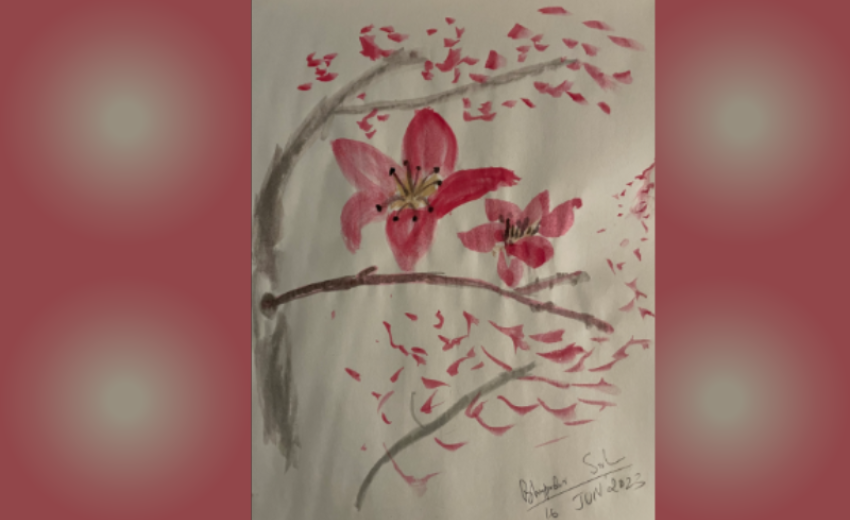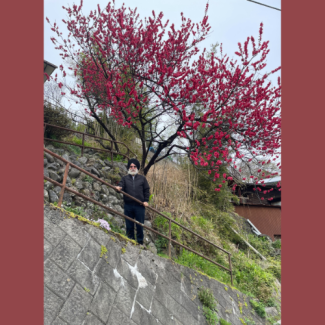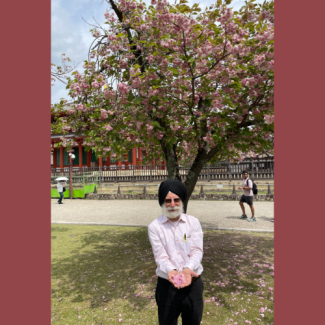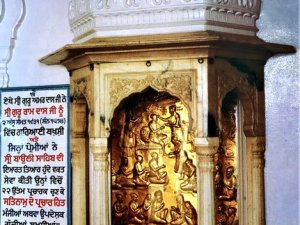In the middle of March 2023, I was in Delhi and one morning I was in a car on the Ring Road going to meet someone. During the drive my eyes fell on the bright red, beautiful flowers of Simal tree. I also saw birds coming there attracted by its beauty and in hopes of finding food there. I was suddenly reminded of Guru Nanak Ji words enshrined in Sri Guru Granth Sahib (SGGS) as:
ਸਿੰਮਲ ਰੁਖੁ ਸਰਾਇਰਾ ਅਤਿ ਦੀਰਘ ਅਤਿ ਮੁਚੁ ॥ ਓਇ ਜਿ ਆਵਹਿ ਆਸ ਕਰਿ ਜਾਹਿ ਨਿਰਾਸੇ ਕਿਤੁ ॥ ਫਲ ਫਿਕੇ ਫੁਲ ਬਕਬਕੇ ਕੰਮਿ ਨ ਆਵਹਿ ਪਤ ॥
“Simal rukh sarairaa at dheeragh at muchh. Oai j aaveh aas kar jaeh niraase kit. Phal phike phul
bakabake ka(n)m na aaveh pat.” (SGGS, Pg. No. 470)
Translation: The Simal tree is straight as an arrow, it is very tall, and very thick (girth). But those birds
which visit it in hopes of nourishment depart disappointed, as its flowers are unwholesome, fruit are tasteless, and leaves are not of any use.
Guru Ji used the metaphor of Simal to describe the haughty person. Bhai Gurdas J has further elaborated on the characteristics of Simal as under:
ਉਚਾ ਲੰਮਾ ਝੰਟੁਲਾ ਵਿਚਿ ਬਾਗ ਦਿਸੰਦਾ।
ਮੋਟਾ ਮੁਢੁ ਪਤਾਲਿ ਜੜਿ ਬਹੁ ਗਰਬ ਕਰੰਦਾ।
ਪਤ ਸੁਪਤਰ ਸੋਹਣੇ ਵਿਸਥਾਰੁ ਬਣੰਦਾ।
ਫੁਲ ਰਤੇ ਫਲ ਬਕਬਕੇ ਹੋਇ ਅਫਲ ਫਲੰਦਾ।
ਸਾਵਾ ਤੋਤਾ ਚੁਹਚੁਹਾ ਤਿਸੁ ਦੇਖਿ ਭੁਲੰਦਾ।
ਪਿਛੋ ਦੇ ਪਛੁਤਾਇਦਾ ਓਹੁ ਫਲੁ ਨ ਲਹੰਦਾ॥੧੦॥
“Uchaa la(n)maa jha(n)Tulaa vich baag dhisa(n)dhaa.
MoTaa mudd pataal jaR bahu garab kara(n)dhaa.
Patt supatar sohane visathaar bana(n)dhaa.
Phul ratae phal bakabake hoi afal fala(n)dhaa.
Saavaa totaa chuhachuhaa tis dhekh bhula(n)dhaa.
Pichho dhe pachhutaidhaa oh fal na laha(n)dhaa. 10.” (Bhai Gurdas Vaar, Pg. No. 36.10)
Translation: Tall, high, and luxuriant, the silk cotton tree seen (looking good) in the garden.
It is proud of its stout trunk and deep roots.
Its beautiful green leaves are adorable, it’s spread wide.
It has attractive red flowers and insipid fruit; it fructifies in vain.
Seeing it, the chirping green parrot gets deluded.
But repents afterwards because it gets no fruit on that tree.
Exactly a month later, I found myself in Japan; where I was fortunate to see some Cherry Blossom blooming splendidly on the grounds of Todaiji Temple in Nara and further east in the old town of Naraijuku. The Cherry blossom season in Japan is around third week of March, but because of the mountainous region, having colder climate these were still in full bloom. I was elated and thankful that although the true Cherry Blossom season was over about a month earlier, I still got the opportunity to admire their beauty with my own eyes. I know that Cherry Blossom festivities are a big celebration in Japan ushering in the arrival of spring after the bitter, freezing, cold months of winter. Suddenly a thought came to me that even in India where the Simal is native tree which blossoms for around spring time, why can’t we have our festivities like the Cherry Blossom festival? Interestingly both these flowers have 5 petals and yellow anther. We need to make a start in some location, and as the word spreads not only more tourists will come to enjoy their beauty, but other cities would also like to have their own festivities around the spring blossoming of this bright flowering tree. Then the connection came to me that Simal can become the symbol of ushering in spring for us too. I was wondering about where the seed should be planted. Again, Guru Nanak words came to my rescue, as I started thinking that ideal place to start it will be a place associated with Guru Ji’s life and it should be Sultanpur Lodhi, where Guru Ji spent considerable time.
Sultanpur Lodhi
The town of Sultanpur Lodhi in Punjab was founded by Bahlol Lodhi in 1443, during the rule of the Lodhi dynasty in India. Daulat Khan Lodhi, Nawab of Punjab had appointed Guru Nanak as his Modi (In-charge) of the state granary, and Guru Ji started his work life there. It is from here that Guru Ji embarked on his 4 long journeys called Udassis in 1504 to share his message with the masses. The town is situated on the south bank of the rivulet called Kali Bein. At present Sultanpur is promoted as a place for religious tourism, but that image will undergo a drastic makeover with spring celebrations.
Simal (also called Semal, Silk-Cotton tree)
The botanical name for this tree is Bombax Ceiba, also known as Silk-cotton tree. It comes alive as soon as spring season strikes the area. This usually happens at the beginning of Chet the first month as per Indian calendar (which is around middle of the March month). In many parts of the country, it is also celebrated as the start of the new year. There is a lot of enthusiasm and excitement at ushering in the spring season as people are looking forward to seeing a relief from the chilly winter which keeps them indoors.
The Simal tree bears spectacular deep red flowers, which are very attractive so the birds’ throng to it in hopes of finding some food. It has a tiny capsule that contains white fibers like cotton when it is fully ripe. Cotton from the capsule is used as fabric filler for pillows, mattresses, and quilts. The fruit of this tree that comes in buds is cooked, eaten, and pickled in some parts, although that is not very common from my own personal experience.
Guru Ji viewed this tree as emblematic of an egoist person because the flowers, leaves and its fruit despite being very attractive in appearance, have insipid taste and insignificant nutritional value. The gorgeous looking flowers captures the attention with their beautiful and bright red colors only to disappoint as these cannot be put to good use. When the massive flower falls to the ground, it make a loud thud, sprinkling the ground with bright red and orange petals. The timing of blossoming of this tree coincides almost with the Cherry Blossom time in Japan, thus provides us with an opportunity for our own indigenous version of ushering in the spring. There is a lot of glamour associated with cherry blossoms in Japan, making it is integrally woven to their cultural fabric, which made me wonder if this can become an icon of ushering in the spring in India. Thus, we will have our own new addition to welcoming of the spring besides Holi celebration.
Promenade
Sultanpur being the town associated with Guru Nanak Dev Ji’s life makes it an ideal location to spread the teachings of Guru Ji through the symbolic tree, which Guru Ji metaphorically employed to convey a personality type. The tree is fire-resistant making it attractive to be used to line the banks of rivulet Bein like a Promenade. It will make that area an attractive spring destination of choice to brighten the day in the midst of bright red flowers. Imagine the early morning and evening landscape in March blooming with bright red flowers of Simal tree making it a cheerful “photo opportunity”. With smart phones now everyone has become photo enthusiasts. The Simal tree lined promenade can additionally be used to convey the messages of Guru Ji’s teaching on hoardings by having the quotes artistically displayed. They can provide a gentle reminder not become attractive for name sake only. This can become a beacon to spread the message of Guru Ji in a fun, and pragmatic settings outdoors. The message given to the visitors in such a setting can make a lasting impression on their minds.
Even the birds coming there and perching themselves on the tree branches would make it a must-visit spot for bird watchers. This attraction if developed aesthetically can grow over time to rival the famed Cherry Blossoms of Japan. It would be a home grown, unique type of experience for everyone to enjoy and bring back the cherished memories. The spectacular Promenade will provide employment to many who can gain employment in the hospitality industry, providing amenities, to vendors selling trinkets, souvenirs etc.
Conclusion
Such a plan would have a humble beginning with a small stretch becoming the nursery of the proposed concept. As the momentum is built over time, there could be many additional ideas incorporated to increase its size and appeal. The organic growth of the Promenade will make it bigger with time ensuring more trees being planted and stretches of tree lined riverbank growing on either end. The city planning authorities should be spearheading these development efforts and soon it could be a phenomenon itself that other cities will be vying to replicate.









